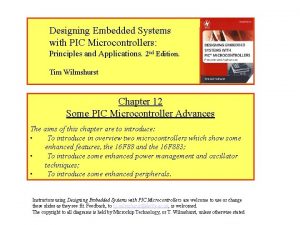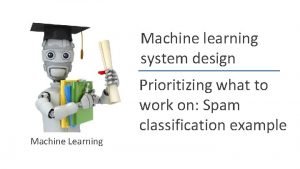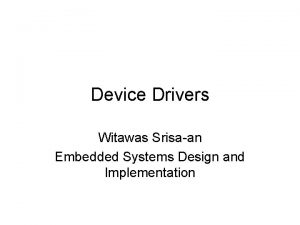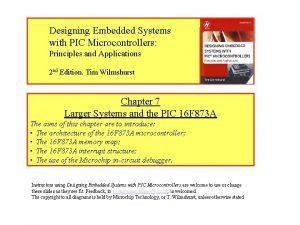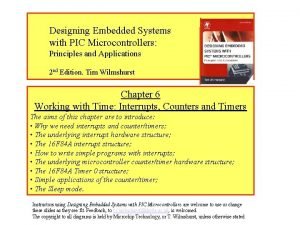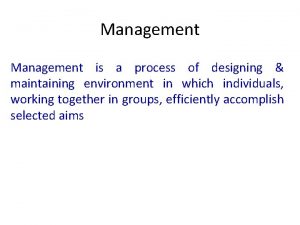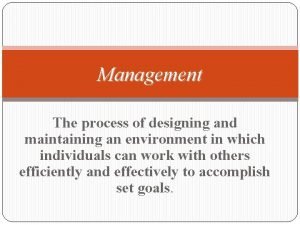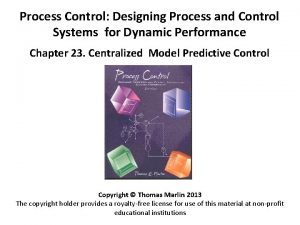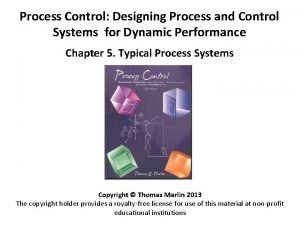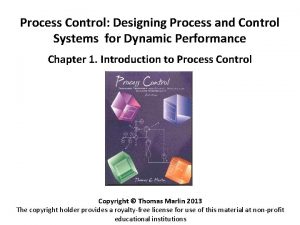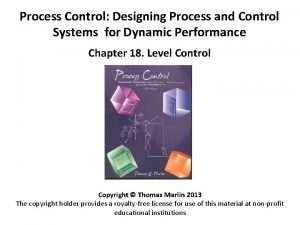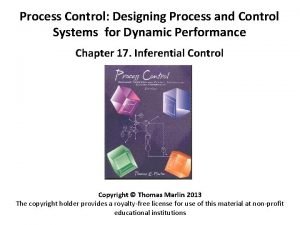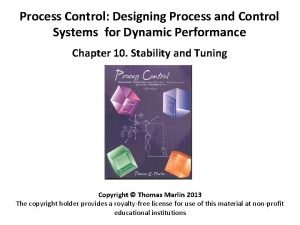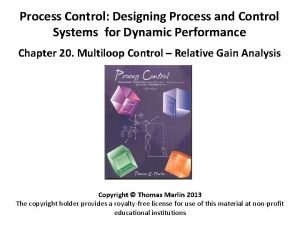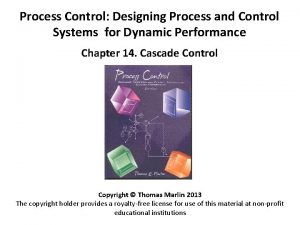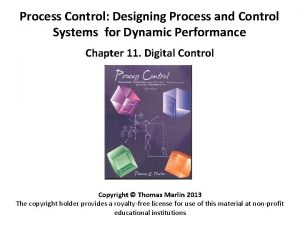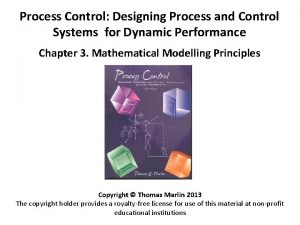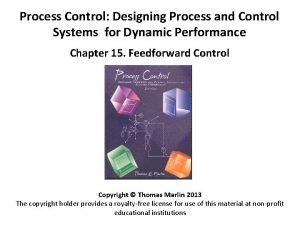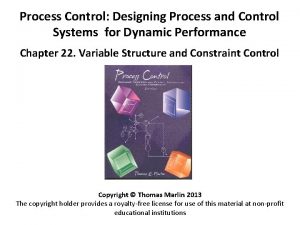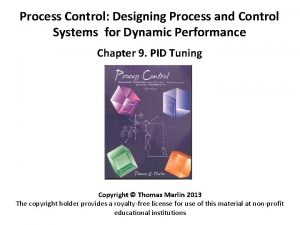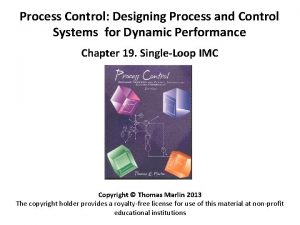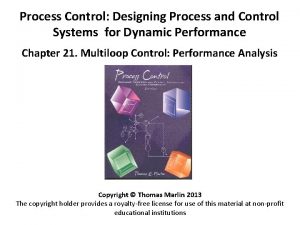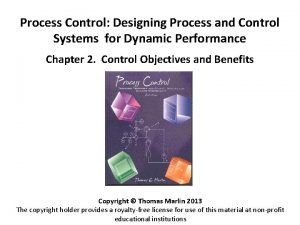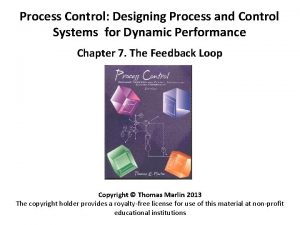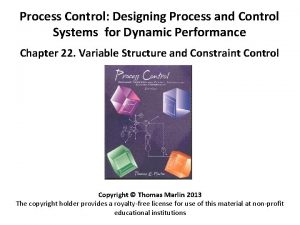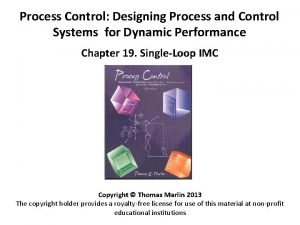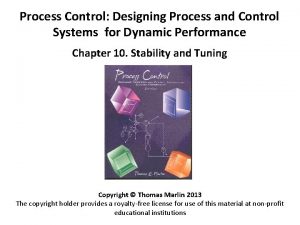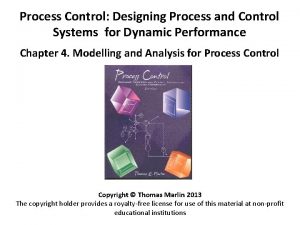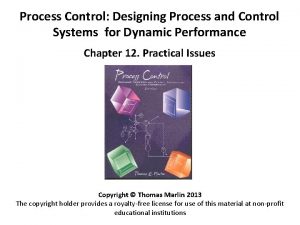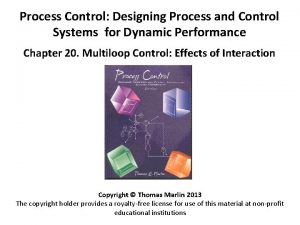Process Control Designing Process and Control Systems for




















































- Slides: 52

Process Control: Designing Process and Control Systems for Dynamic Performance Chapter 20. Multiloop Control Part IV: Relative Gain Array Copyright © Thomas Marlin 2016 The copyright holder provides a royalty-free license for use of this material at non-profit educational institutions

Chapter 20. Multiloop Control, Part IV: Relative Gain Array Instructor for this lesson Dr. Tom Marlin Course architect and instructor Mc. Master University

CHAPTER 20: Multi-loop Control: Relative Gain Array R R AC-1 Controller “on” Controller “off” FV FV AC-2

CHAPTER 20: Multi-loop Control: Relative Gain Array Goals • Use Relative Gain Array to quantify key aspects of interaction • Understand how strong interaction can lead to changes in process gain • Use the Relative Gain Array to determine key performance characteristic – Integrity • Use Relative Gain Array as one factor in control design RGA = Relative Gain Array

CHAPTER 20: Multi-loop Control: Relative Gain Array OUTLINE • Definition of the RGA • Key RGA mathematical properties • Evaluation of RGA for process systems • Interpretation of relative gain values • Control design guidelines based on RGA • Workshop

CHAPTER 20: Multi-loop Control: Relative Gain Array Let’s see how interaction can “flip the sign” of a process gain When |CVD(s)| < |CVI(S)|and CVD(s)/CVI(S) < 0 , the sign of the process gain changes CVD(s) MV 1(s) “direct path” G 11(s) + “interaction path” CVI(S) CV 1(s) = CVD(s) + CVI(S) G 21(s) G 12(s) MV 2(s) SP 2(s) + - Gc 2(s) G 22(s) + + CV 2(s)

CHAPTER 20: Multi-loop Control: Relative Gain Array What condition can “flip the sign” of a process gain? CVD(s) MV 1(s) “direct path” G 11(s) + CV 1(s) = CVD(s) + CVI(S) “interaction path” CVI(S) We will limit our analysis to the behavior. G 21 steady-state (s) • KP 1 = CV 1 / MV 1 G 12(s) MVnegative • KP 1 * KC 1 > 0 for (stabilizing) feedback control 2(s) • When conditions hold, + + the following Gc 2(s) G 22(s) + |CV (s)| < |CV (S)|and CV (s)/CV (S) < 0 D I SP (s) 2 CV 2(s) The sign of KP 1 changes depending on whether the other control loop is “on”. The sign of KC 1 is unchanged, so when the GC 1 control is on, the system becomes unstable!

CHAPTER 20: Multi-loop Control: Relative Gain Array Integrity and interaction – a key property. CVD(s) MV 1(s) “direct path” G 11(s) + “interaction path” CV 1(s) = CVD(s) + CVI(S) INTEGRITY: A control system. G 21 has (s) integrity when after one or more loops is placed “off”, the remaining control system can be stable without changing the signs of controllers that remain “on”. G 12(s) When the following conditions hold, MV 2(s) |CVD(s)| < |CVI(S)|and CVD(s)/CVI(S) < 0 + Gc 2 not (s) have integrity. G 22(s) (This + is BAD. ) + The system does SP 2(s) - CV 2(s) How can we determine whether a system will have integrity? The Relative Gain Array -- RGA

CHAPTER 20: Multi-loop Control: Relative Gain Array Definition of Relative Gain. The relative gain between MVj and CVi is designated by ij and defined below. The Array is the matrix with elements ij. Other loops have integral modes, so they keep their CV’s constant (at steady state).

CHAPTER 20: Multi-loop Control: Relative Gain Array OUTLINE • Definition of the RGA • Key RGA mathematical properties • Evaluation of RGA for process systems • Interpretation of relative gain values • Control design guidelines based on RGA • Workshop

CHAPTER 20: Multi-loop Control: Relative Gain Array 1. The RGA can be calculated from openloop gains (only). Open-loop: MV independent Closed-loop: CV independent The relative gain array is the element-by-element product of K with K-1. ( = product of ij elements, not normal matrix multiplication) Relative Gain Array

CHAPTER 20: Multi-loop Control: Relative Gain Array 1. The RGA can be calculated from openloop values. The relative gain array for a 2 x 2 system is given in the following equation. What is true for the RGA to have 1’s on diagonal?

CHAPTER 20: Multi-loop Control: Relative Gain Array 2. The RGA elements are scale independent. What is the effect of changing the units of the CV, expressing CV as % of instrument range, or changing the capacity of the final element on ij ? Original units Modified units CV*2 = CV 2/10 MV*1 = 10 MV 1

CHAPTER 20: Multi-loop Control: Relative Gain Array 3. The rows and columns of the RGA sum to 1. 0. For a 2 x 2 system, how many elements are independent?

CHAPTER 20: Multi-loop Control: Relative Gain Array 4. In some cases, the RGA is very sensitive to small errors in the gains, Kij. When is this equation very sensitive to errors in the individual gains? When the term approaches 1. 0

CHAPTER 20: Multi-loop Control: Relative Gain Array 5. A permutation in the gain matrix (changing CVs and MVs) results in the same permutation in the RG Array. Process Gain Matrix RGA

CHAPTER 20: Multi-loop Control: Relative Gain Array OUTLINE • Definition of the RGA • Key RGA mathematical properties • Evaluation of RGA for process systems • Interpretation of relative gain values • Control design guidelines based on RGA • Workshop

CHAPTER 20: Multi-loop Control: Relative Gain Array The steady-state gains used to calculate the RGA can be determined by several methods. Analytical models Numerical derivatives from flowsheet Experimentation Most models are too complex for this method Experimental errors likely give unreliable answers Check linearization using +/- x , reduce x until accuracy obtained.

CHAPTER 20: Multi-loop Control: Relative Gain Array Specific approach used to evaluate the RGA of a system with integrating processes, such as levels. Redefine the dependent variable as the derivative of the level; then, calculate RGA as normal. (Note that L is unstable, but d. L/dt is stable. ) m 1 = density L A D = density m 2 Model

CHAPTER 20: Multi-loop Control: Relative Gain Array Specific approach used to evaluate the RGA of a system with integrating processes, such as levels. Redefine the dependent variable as the derivative of the level; then, calculate RGA as normal. (Note that L is unstable, but d. L/dt is stable. ) m 1 = density L A D = density m 2 Relative Gain Array

CHAPTER 20: Multi-loop Control: Relative Gain Array 1. 2. Other control loops (not in RGA) affect RGA! Process operating conditions affects the RGA! Rel. vol = 1. 2, R = 1. 2 Rmin Data from Mc. Avoy, 1983

CHAPTER 20: Multi-loop Control: Relative Gain Array OUTLINE • Definition of the RGA • Key RGA mathematical properties • Evaluation of RGA for process systems • Interpretation of relative gain values • Control design guidelines based on RGA • Workshop

CHAPTER 20: Multi-loop Control: Relative Gain Array ij > 0 In this case, the multiloop steady-state gain and the single-loop gain have the same sign! MVj Kij CVi • The sign of Kij does not depend on the “on/off” status of other control loops in the plant. • The sign of the controller gain, Kci, for negative feedback does not depend on the “on/off” status of other control loops in the plant. • Because the magnitude of Kij can change significantly between single and multiloop, there is no guarantee of stability or good performance (without changing Kci magnitude).

CHAPTER 20: Multi-loop Control: Relative Gain Array 0< ij<1 In this case, the multiloop (ML) process steadystate gain is larger than the single-loop (SL) gain. MVj Kij CVi • What would be the effect on dynamic performance of closing the other loops? The SL tuning requires a larger controller gain, Kci. If the controller is tuned well for SL, closing the other loops (without changing Kci) will result in aggressive feedback control, perhaps even instability.

CHAPTER 20: Multi-loop Control: Relative Gain Array ij= 1 In this case, the steady-state gains are identical in both the ML and the SL conditions. MV 1(s) G 11(s) + G 21(s) + CV 1(s) Gd 1(s) D(s) G 12(s) MV 2(s) G 22(s) Gd 2(s) + + CV 2(s) • What is generally true when ij= 1 ? • Does ij= 1 indicate no interaction?

CHAPTER 20: Multi-loop Control: Relative Gain Array ij= 1 In this case, the steady-state gains are identical in both the ML and the SL conditions. Solvent CSTR with zero heat of reaction Reactant FS >> FR AC TC • Cooling flow affect the reaction rate • Small reactant flow does not affect temperature

CHAPTER 20: Multi-loop Control: Relative Gain Array ij= 1 In this case, the steady-state gains are identical in both the ML and the SL conditions. Diagonal gain matrix Lower diagonal gain matrix 0 Both give an RGA that is identity matrix! 0 0 An identity RGA does not mean no interaction, it signifies that no “two-way” process interaction exists

CHAPTER 20: Multi-loop Control: Relative Gain Array 1< ij In this case, the steady-state multiloop (ML) gain is smaller than the single-loop (SL) gain. MVj Kij CVi • What would be the effect on dynamic performance of closing the other loops? The SL tuning requires a smaller controller gain, Kci. If the controller is tuned well for SL, closing the other loops (without changing Kci) will result very slow feedback. • We cannot increase the tuning for multiloop because of stability issues. (See multiloop tuning exercise. )

CHAPTER 20: Multi-loop Control: Relative Gain Array ij = 0 In this case, the steady-state gain is zero when all other loops are open, in manual. TC Sometimes called “nested loops” LC Heating tank without boiling • Could this control system work? Yes • What would happen if TC were “off”? There would be no causal relationship between heating flow and level.

CHAPTER 20: Multi-loop Control: Relative Gain Array ij < 0 In this case, the steady-state gain has a different sign depending on the status (auto/manual) of the other loops. A 2 C FS >> FA Solvent CA 0 CSTR with A B Pure A CA A 1 C • With A 2 C “off”, increasing pure A flow increases CA 0, which increases CA. Kp > 0 • With A 2 C “on”, increasing pure A flow does not affect CA 0, which is controlled. The result is the total flow rate increases, which decreases space time and CA Kp < 0

CHAPTER 20: Multi-loop Control: Relative Gain Array ij= In this case, the gain in the ML situation is zero. We conclude that ML control is not possible. We have encountered this condition when we learned about controllability. ij= is equivalent to an uncontrollable system. F 1 P 1 Constant speed motor P 2 v 1 v 2 Centrifugal pump The level and temperature cannot be controlled by adjusting v 1 and v 2.

CHAPTER 20: Multi-loop Control: Relative Gain Array OUTLINE • Definition of the RGA • Key RGA mathematical properties • Evaluation of RGA for process systems • Interpretation of relative gain values • Control design guidelines based on RGA • Workshop

CHAPTER 20: Multi-loop Control: Relative Gain Array RGA and INTEGRITY • INTEGRITY: A stable multiloop control system has good integrity when after one loop is turned off, the remainder of the control system remains stable. • We conclude that the RGA provides important insight into the INTEGRITY of a multiloop control system. • “Turning off” can occur when (1) a loop is placed in manual, (2) a valve saturates, or (3) a lower level cascade controller no longer changes the valve (in manual or reached set point limit). Not unusual

CHAPTER 20: Multi-loop Control: Relative Gain Array Guideline #1 : Select pairings that do not have any ij < 0 Integrity is an important property for a control system. CV-MV pairings related to negative relative gain elements have poor integrity. Avoid negative relative gains

CHAPTER 20: Multi-loop Control: Relative Gain Array Guideline #2 : Select pairings that do not have any ij=0 Turning one loop “off” should not affect the ability of the remaining loops to perform correctly. A loop should not lose controllability due to another loop being “off”. Avoid zero relative gains Caution: Exceptions shown in Chapter 22

CHAPTER 20: Multi-loop Control: Relative Gain Array Guideline #3 : Select a pairing that has RGA elements as close as possible to ij=1 With RGA elements near 1. 0, the tuning of single-loop and multiloop are nearly the same. Therefore, complex real-time retuning depending on loop status is not required. Pairing one elements near 1. 0 reduces “interaction”, which sometimes (not always) contributes to good control performance. Cautions: 1. Dynamics is also important 2. Important exceptions shown in Chapter 21 based on disturbances

CHAPTER 20: Multi-loop Control, Relative Gain Array How did we do? • Use Relative Gain Array to quantify key aspects of interaction • Understand how strong interaction can lead to changes in process gain • Use the Relative Gain Array to determine key performance characteristic – Integrity • Use Relative Gain Array as one factor in control design Lot’s of improvement! But refer to the next slide for a caution.

CHAPTER 20: Multi-loop Control: Relative Gain Array Caution: There is more learning in multiloop systems • Limited to (a) selected CV/MV (b) operating conditions, (c) design on other loops implemented and external to RGA analysis • RGA interpretation changes for unstable plants • RGA based on steady-state information, while control performance is influenced by dynamics • Many plants have an unequal number of MVs and CVs • Control design involves structures other than multiple single-loop • Control performance is influenced by disturbances, which are not considered in RGA! Apparently, there is a lot more to learn!

CHAPTER 20: Multi-loop Control, Multiloop Tuning LEARNING RESOURCES • PC-EDUCATION WEB SITE - Process Control Learning Support – Chapter 20 + Quiz (with solutions) + Tutorials (with solutions) • TEXTBOOK - Chapter 20 Edgar Bristol invented the RGA Bristol, E. , "On a New Measure of Interaction for Multivariable Process Control, " IEEE Trans. Auto. Control, AC-I 1, 133 -134 (1966). Mc. Avoy, T. , Interaction Analysis, Instrument Society of America, Research Triangle Park, NC, 19836.

CHAPTER 20: Multi-loop Control, Multiloop Tuning CITATIONS None!

CHAPTER 20: Multi-loop Control: Relative Gain Array OUTLINE • Definition of the RGA • Key RGA mathematical properties • Evaluation of RGA for process systems • Interpretation of relative gain values • Control design guidelines based on RGA • Workshop

CHAPTER 20: Multi-loop Control: Relative Gain Array Workshops on Relative Gain Array

CHAPTER 20: Multi-loop Control: Relative Gain Array Workshop 1: Packed bed reactor The effluent temperature and composition for the two packed bed reactors are controlled by adjusting the interstage quench flow rate and temperature. The dynamics are given below. TQ Determine the relative gain array for this process. T C FQ

CHAPTER 20: Multi-loop Control: Relative Gain Array Workshop 2. Effect of cascade on RGA The RGA has been evaluated, but the regulatory control system (below the loops being analyzed using RGA) has been modified. Instead of adjusting a valve directly, one of the loops being evaluated will adjust a flow controller set point (which adjusts the same valve). How would you evaluate the new RGA?

CHAPTER 20: Multi-loop Control: Relative Gain Array Workshop 3. Information from RGA Discuss what information can be obtained from the RGA and some important information for control design that cannot be obtained.

CHAPTER 20: Multi-loop Control: Relative Gain Array Workshop 4. RGA from closed-loop data You would like to evaluate the steady-state RGA for a process, but the feedback controllers must remain in automatic status. How can you obtain the needed data? • Explain a procedure that might yield the needed information. • Discuss the practicality of the approach.

CHAPTER 20: Multi-loop Control: Relative Gain Array Workshop 5. Pair loop on negative RGA element You have decided to pair on a loop that has a negative RGA element. Discuss the tuning that is appropriate for these loops. A Solvent CA 0 CSTR with A B A CA A

CHAPTER 20: Multi-loop Control: Relative Gain Array Workshop 6. Effect of operating conditions on RGA

CHAPTER 20: Multi-loop Control: Relative Gain Array Workshop 6. continued

CHAPTER 20: Multi-loop Control: Relative Gain Array Workshop 7. RGA row-column sum Prove the statement that the rows and columns of the RGA sum to 1. 0. Hint: a matrix and its inverse commute, i. e. , K K-1 = K-1 K = I

CHAPTER 20: Multi-loop Control: Relative Gain Array Workshop 7. RGA row-column sum The rows and columns of the RGA sum to 1. 0. K K-1 = I = K-1 K From the left hand equation, the elements of I are equal to From the right hand equation, the elements of I are equal to

CHAPTER 20: Multi-loop Control: Relative Gain Array Workshop 8. Pair on zero RGA element Determine the relative gain array for the TC and VC controllers. Discuss the behavior of this design and generalize the conclusions. To the SP of the feed flow FC MV from the VC controller LC TC SP = 95% open VC MV from the TC controller CV to the VC controller
 Designing embedded systems with pic microcontrollers
Designing embedded systems with pic microcontrollers Machine learning system design examples
Machine learning system design examples Designing device drivers for embedded systems
Designing device drivers for embedded systems Designing embedded systems with pic microcontrollers
Designing embedded systems with pic microcontrollers Designing embedded systems with pic microcontrollers
Designing embedded systems with pic microcontrollers The process of designing and maintaining an environment
The process of designing and maintaining an environment Process of textbook designing and development
Process of textbook designing and development The process of designing and maintaining an environment
The process of designing and maintaining an environment The main issue in designing process layouts concerns what
The main issue in designing process layouts concerns what Minimum cycle length
Minimum cycle length Systemactio
Systemactio Dairy plant management
Dairy plant management Formuö
Formuö Typiska drag för en novell
Typiska drag för en novell Tack för att ni lyssnade bild
Tack för att ni lyssnade bild Returpilarna
Returpilarna Varför kallas perioden 1918-1939 för mellankrigstiden?
Varför kallas perioden 1918-1939 för mellankrigstiden? En lathund för arbete med kontinuitetshantering
En lathund för arbete med kontinuitetshantering Personalliggare bygg undantag
Personalliggare bygg undantag Tidbok yrkesförare
Tidbok yrkesförare A gastrica
A gastrica Förklara densitet för barn
Förklara densitet för barn Datorkunskap för nybörjare
Datorkunskap för nybörjare Stig kerman
Stig kerman Mall debattartikel
Mall debattartikel Autokratiskt ledarskap
Autokratiskt ledarskap Nyckelkompetenser för livslångt lärande
Nyckelkompetenser för livslångt lärande Påbyggnader för flakfordon
Påbyggnader för flakfordon Kraft per area
Kraft per area Offentlig förvaltning
Offentlig förvaltning Jag har nigit för nymånens skära text
Jag har nigit för nymånens skära text Presentera för publik crossboss
Presentera för publik crossboss Jiddisch
Jiddisch Vem räknas som jude
Vem räknas som jude Klassificeringsstruktur för kommunala verksamheter
Klassificeringsstruktur för kommunala verksamheter Fimbrietratt
Fimbrietratt Bästa kameran för astrofoto
Bästa kameran för astrofoto Cks
Cks Byggprocessen steg för steg
Byggprocessen steg för steg Mat för unga idrottare
Mat för unga idrottare Verktyg för automatisering av utbetalningar
Verktyg för automatisering av utbetalningar Rutin för avvikelsehantering
Rutin för avvikelsehantering Smärtskolan kunskap för livet
Smärtskolan kunskap för livet Ministerstyre för och nackdelar
Ministerstyre för och nackdelar Tack för att ni har lyssnat
Tack för att ni har lyssnat Vad är referatmarkeringar
Vad är referatmarkeringar Redogör för vad psykologi är
Redogör för vad psykologi är Matematisk modellering eksempel
Matematisk modellering eksempel Atmosfr
Atmosfr Borra hål för knoppar
Borra hål för knoppar Vilken grundregel finns det för tronföljden i sverige?
Vilken grundregel finns det för tronföljden i sverige? Formel gruplar
Formel gruplar Tack för att ni har lyssnat
Tack för att ni har lyssnat
